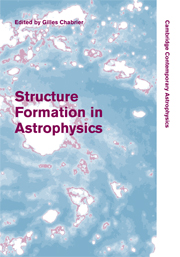Book contents
- Frontmatter
- Contents
- List of contributors
- Preface
- Part I Physical Processes and Numerical Methods Common to Structure Formations in Astrophysics
- Part II Structure and Star Formation in the Primordial Universe
- Part III Contemporary Star and Brown Dwarf Formation
- Part IV Protoplanetary Disks and Planet Formation
- 13 Observational properties of disks and young stellar objects
- 14 Structure and dynamics of protoplanetary disks
- 15 Planet formation and evolution: theory and observations
- 16 Planet formation: assembling the puzzle
- Part V Summary
15 - Planet formation and evolution: theory and observations
Published online by Cambridge University Press: 11 August 2009
- Frontmatter
- Contents
- List of contributors
- Preface
- Part I Physical Processes and Numerical Methods Common to Structure Formations in Astrophysics
- Part II Structure and Star Formation in the Primordial Universe
- Part III Contemporary Star and Brown Dwarf Formation
- Part IV Protoplanetary Disks and Planet Formation
- 13 Observational properties of disks and young stellar objects
- 14 Structure and dynamics of protoplanetary disks
- 15 Planet formation and evolution: theory and observations
- 16 Planet formation: assembling the puzzle
- Part V Summary
Summary
Introduction
This chapter is devoted to planet formation and to the early stages of evolution of low-mass objects, including low-mass stars, brown dwarfs and exoplanets. We first summarize the general properties of current exoplanet observations (Section 15.2) and describe the two main planet formation models based on disk instability and on the core-accretion scenario, respectively (Section 15.3). Recent progress of the latter formation model allows sophisticated population synthesis analyses which provide fully quantitative predictions that can be compared to the observed statistical properties of exoplanets (Section 15.3.5). The last part of this chapter is devoted to the distinction between brown dwarfs and planets, in terms of structure and evolutionary properties. The existence of a mass overlap between these two distinct populations of low-mass objects is highlighted by the increasing discoveries of very massive exoplanets (M ≳ 5MJ) and by the identification of planetary mass brown dwarfs in young clusters (M ≲ 10MJ) These discoveries stress the importance to define signatures which could allow to disentangle a brown dwarf from a planet. We first analyse the effect of accretion on the evolution of young brown dwarfs and the resulting uncertainties of evolutionary models at ages of a few million years. We also analyse different specific signatures of brown dwarfs and planets such as their luminosity at young ages, their radii and their atmospheric properties.
- Type
- Chapter
- Information
- Structure Formation in Astrophysics , pp. 378 - 409Publisher: Cambridge University PressPrint publication year: 2009
- 1
- Cited by

